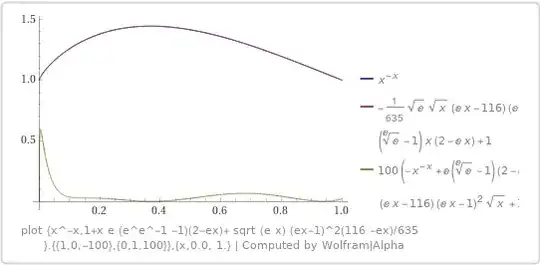Big hint for the new year .
I simplify the answer of RiverLi we have for $x\in[1,3]$:
$$2^{1.449}x^{\frac{42}{100}}e^{-x^{1+\frac{42}{100}}}>x^{-x}$$
And using the Sophomore dream as RiverLi we have :
$$\int_{0}^{\infty}x^{-x}dx<\int_{1}^{3}2^{1.449}x^{\frac{42}{100}}e^{-x^{1+\frac{42}{100}}}dx+\int_{0}^{1}x^{-x}dx+\int_{3}^{\infty}3^{-x}e^{\left(-x+3\right)}dx<2$$
All the integral are easy and we are done !
Edit we have better in fact :
$$\int_{0}^{\infty}x^{-x}dx<\int_{1}^{5}ex^{\frac{12}{1000}+\frac{2}{5}}e^{-x^{\frac{12}{1000}+1+\frac{2}{5}}}dx+\int_{0}^{1}x^{-x}dx+\int_{5}^{\infty}x^{-x}dx$$
Or :
$$\int_{0}^{\infty}x^{-x}dx<\int_{1}^{5}ex^{\frac{12}{1000}+\frac{2}{5}}e^{-x^{\frac{12}{1000}+1+\frac{2}{5}}}dx+\int_{0}^{1}x^{-x}dx+\int_{5}^{\infty}5^{-x}dx$$
Where we have the inequality for $x\in[1,5]$ :
$$ex^{\frac{12}{1000}+\frac{2}{5}}e^{-x^{\frac{12}{1000}+1+\frac{2}{5}}}\geq x^{-x}\tag{I}$$
This inequality can be hadle with logarithm and derivative .
It leads us to using the Sophomore dream as RiverLi :
$$\int_{0}^{\infty}x^{-x}dx<e\cdot\frac{250}{353}\left(\frac{1}{e}-e^{-5^{1+\frac{103}{250}}}\right)+\frac{1}{3125\ln5}+\frac{27891287}{21600000}+\frac{1}{38800}<2$$
Or :
$$\int_{0}^{\infty}x^{-x}dx<\frac{250}{353}+\frac{1}{3125\ln5}+\frac{27891287}{21600000}+\frac{1}{38800}<2$$
I don't know if it could be shown by hand .
Some details :
$(I)$ proof :
We introduce the function :
$$f(x)=\ln\left(ex^{\frac{12}{1000}+\frac{2}{5}}e^{-x^{\frac{12}{1000}+1+\frac{2}{5}}}\right)-\ln\left(x^{-x}\right)$$
We have :
$$f'(x)=-\frac{353}{250}x^{\frac{103}{250}}+\frac{103}{250x}+1+\ln x$$
And :
$$f''(x)=\frac{-\left(36359x^{\frac{353}{250}}-62500x+25750\right)}{62500x^{2}}$$
The interesting part of the second dervative is :
$$g(x)=-\left(36359x^{\frac{353}{250}}-62500x+25750\right)$$
We have :
$$g'\left(\frac{61035156250000000\cdot2^{\frac{29}{103}}\cdot5^{\frac{87}{103}}}{164730217164529\cdot103^{\frac{44}{103}}\cdot353^{\frac{88}{103}}}\right)=0$$
Wich says for this value the function $g(x)$ have a maxima and :
$g(2.134...)=0$
Call $U=2.134...$
Now for $f'(x)$ we have $f(1)=0$ and $f'(x)$ is increasing before $x\in[1,U]$ and decreasing for $[U,5]$ with a zero at $V=3.66...$
Recalling that $f(1)=0,f(5)>0$ it shows the inequality $(I)$
For the integral :
$$\int_{1}^{5}ex^{\frac{12}{1000}+\frac{2}{5}}e^{-x^{\frac{12}{1000}+1+\frac{2}{5}}}dx$$
have the form $p'(x)r'(p(x))$ which is straightforward to integrating .
For the Sophomore Dream see RiverLi's answer .

